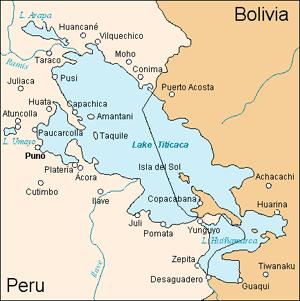 |
||||||
|
Enjoy This Site?
Then why not use the button below, to add us to your social networking site or your favorite bookmarking service? |
Lake Titicaca
Titicaca Lake borders both Peru and Bolivia. This majestic lake is one of the highest lakes in the world and is the largest freshwater lake in South America. The lake was once home to the great Inca empire. Evidence of ancient Inca ruins can be seen all over Titicaca, especially on an island called Isla del Sol.There are also several other islands on the lake that contain Inca ruins. Today indigenous people continue to live throughout the Lake Titicaca region, such as the Aymara people, who's culture was greatly influenced by the Incas and you'll find that many of the traditions of the Inca era still exist. Lake Titicaca has become a popular tourist destination. Most travelers stay in Copacabanawhich serves as a hub for exploring the numerous islands that contain Inca ruins on Lake Titicaca. Getting ThereThe main destination in Lake Titicaca is Copacabana, which is a city right off the shores of the lake. Copacabana is a city of about 15,000 people, there you'll find many hotels, restauants and tour agencies. The city is kind of the hub for other sites around Lake Titicaca. In Copacabana there are many tour agencies that offer day trips to the different islands and Inca ruins around the lake.Buses from La Paz to Copacabana leave daily from the Cementerio District in La Paz. A one-way ticket costs about 20Bs ($2.50). The ride takes 3-4 hours, including a ferry ride through the Straits of Tiquina. Buses from Puno (Peru) to Copacabana cost $2 US and take about 2 hours or you can just stay in Puno to explore Lake Titicaca, since there are plenty of tour agencies that give tours of the lake also. There are many tour companies in La Paz and Peru that offer a tour of Lake Titicaca. These guided tours begin in La Paz or Peru, where they pick you up at your hotel with their bus. You then drive to Lake Titicaca and get on a little cruise boat to check out the Inca ruins at the main Islands. The guided tours include a stop in Copacabana to see the church. Lunch and snacks are served on the cruise boat. Click Here to Get FREE Travel Brochures on Lake Titicaca! Most Interesting Sights Tiahuanaco (Tiwanaku) is an ancient city that consist of pre-Inca ruins that archaeologists believe were built before the birth of Christ. It is one of the most fascinating places to visit. The ruins are located near Lake Titicaca, about 45 miles (72km) west of La Paz along paved roads. Tiahuanaco (Tiwanaku) is an ancient city that consist of pre-Inca ruins that archaeologists believe were built before the birth of Christ. It is one of the most fascinating places to visit. The ruins are located near Lake Titicaca, about 45 miles (72km) west of La Paz along paved roads.
Lake Titicaca Map & Geography Lake Titicaca is a lake located on the border of Bolivia and Peru in South America. The western part of the lake lies within the Puno, Peru region, and the eastern side is located near the La Paz, Bolivia region. Lago Titicaca covers about 3,200 square miles (8,300 square km) and is more than 120 miles long and 50 miles wide. A narrow strait, Tiquina, separates the lake into two bodies of water The lake is fed by rainfall and meltwater from glaciers on the Andean Mountains. Five major river systems feed into the lake. There are also more than 20 other smaller rivers, that empty into the lake. Titicaca Lake is nearly a closed lake. Water passes through a single outlet at the Rio Desaguader, which then flows south through Bolivia to Lake Poopó. This only accounts for about 10% of the lake's water balance. The other 90% is lost by evaporation caused by strong winds and intense sunlight at the high altitude. HistoryBefore the Incas, the Titicaca region was inhabited by the Tiahuanaco. Ruins of the Tiahuanaco(Tiwanaku) still exist today and are a popular tourist attraction on the southeast side of the lake near La Paz, BoliviaAfter the fall and disappearance of the Tiahuanaco culture around 1100 AD, the great Inca empire was born in the Titicaca region. According to Inca legend it is where the sun god's children, Manco Capac and Mama Ocllo ("Adam & Eve" of the Incas), emerged from the depths of Lake Titicaca and found the Inca civilization. WildlifeLake Titicaca's two native fish species are as Karachi (Orestia) and Boga (Trichomycterus-in the catfish family). Over the years these species have decreased in population and are considered vulnerable and endangered.Non-native fish species such as trout and mackerel were introduced into Lake Titicaca in the 1930's. Trout is a favorite dish around the lake. The Titicaca frog can weigh up to 2 pounds and reach a length of over a foot. This frog is very unique and is found only in Titicaca and nowhere else. It has adapted to the high-altitude habitat of Lake Titicaca. About the size of a salad plate, the frog absorbs oxygen directly through its superfluous skin so it can stay submerged for long periods of time, avoiding high levels of ultraviolet radiation and other hazards. Titicaca frog legs are popular on restaurant menus around the lake. WeatherFrom February to November the climate around Lake Titicaca is mostly pleasant and sunny, but there's often a cool wind off the lake and nights can get very cold. Most rainfall occurs in midsummer, December through January. The Average year around temperature is about 53°F (12°C).Due to its high altitude, Lake Titicaca's water absorbs large amounts of solar radiation, therefore that keeps the water temperature constantly the same year around. The water temperatures averages 51º F (11º C). Interesting TriviaOther Related Pages: |
|||||


